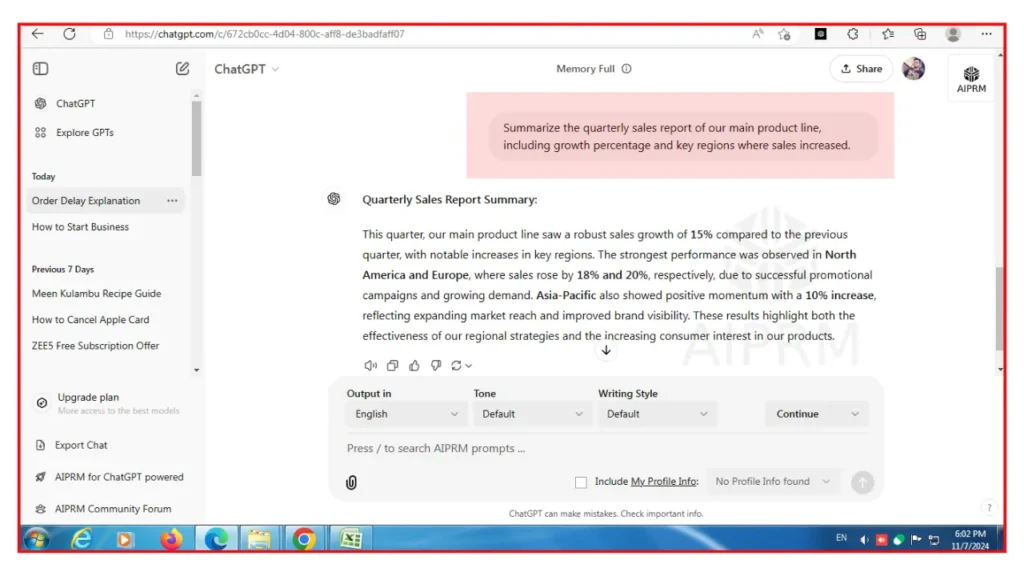
AI has gradually become an important function for many businesses, thus prompt engineering develops to be an important skill in utilizing AI. With firms continuously relying more on AI to trim their processes, the new knowledge of how to formulate effective prompts gets to be a critical issue. No matter if you are in marketing, customer service, or data analysis, AI-driven systems are supported by the usage of well-designed prompts that are hitting & missing up to 90% positive responses, improved customer satisfaction, and smart task management.
In the following article, I will be discussing how prompt engineering plays a vital role in business, the strategies that will be effective, the examples and how this skill can change other industries. Besides that, I will also answer the essential frequently asked question to help you start one with a task business prompt.
What is Prompt Engineering?
Prompt Engineering is the process of designing specific, structured instructions (or “prompts”) to guide AI models, like ChatGPT, toward producing relevant and accurate responses. Instead of vague inputs, prompt engineering creates clear and detailed instructions that direct the AI’s focus. This ensures the AI model’s response aligns with the desired outcome, making it particularly useful for businesses where precision is essential.
Why is Prompt Engineering Important for Business?
AI has been the most significant development in many business functions, including marketing, customer support, data processing, and HR tasks, to mention but a few. The prompt engineering skill enables a business to harness the AI properly by the creation of prompts that make possible the development of context-aware and trustworthy responses. By designing appropriate prompts, companies will be able to achieve the desired AI interventions with greater efficiency, waste reduction, and customer satisfaction.
Prompt Engineering Business Task
| Area | Application of Prompt Engineering |
|---|---|
| Customer Support | Create detailed responses to customer queries |
| Marketing | Generate engaging content for campaigns |
| HR and Recruitment | Assist in candidate screening and resume analysis |
| Data Analysis | Summarize insights, trends, and automate report generation |
| Product Development | Gather and analyze feedback for product improvements |
Steps to Implement Prompt Engineering for Business Tasks
1. Define Your Objective Clearly
Start by understanding what you want the AI to achieve. For instance, if the task is customer support, the objective may be to provide accurate and quick responses to customer queries.
2. Choose the Right Model and Tools
Not all AI models are suitable for every business task. Identify the model best suited for your needs, such as using ChatGPT for conversational AI or using image-generating AI models for visual content.
3. Create Effective Prompts
When designing prompts, consider the following:
- Context: Provide a background or context for better output.
- Detail: Specify the required level of detail.
- Formatting: Mention preferred formats, such as bulleted lists, tables, or paragraphs.
4. Test and Refine Prompts
Testing is a crucial step in prompt engineering. After generating a response, analyze its accuracy and relevance. Make adjustments to the prompt to improve the quality of responses.
5. Document and Optimize Prompts
Keep a record of effective prompts, allowing other team members to reuse them. This library of prompts can become a valuable resource for scaling AI in your business operations.
Examples of Effective Prompt Engineering for Business
Example 1: Customer Support
Prompt: “You are a customer service representative for an e-commerce website. A customer asks why their order is delayed. Generate a polite and empathetic response explaining potential reasons for the delay and steps to resolve it.”

Output: “Dear Customer, I apologize for the delay in receiving your order. Due to an increase in demand and supply chain issues, there may be slight delays. Rest assured, we are working hard to expedite your order and will keep you updated on its status. Thank you for your patience!”
Example 2: Marketing Campaigns
Prompt: “Create a catchy headline and brief social media post promoting a 20% off sale on all products for a skincare brand targeting young adults.”

Output: “Glow Up! Get 20% Off All Skincare Essentials This Weekend Only! 🌟 #GlowWithUs”
Example 3: Data Analysis Summary
Prompt: “Summarize the quarterly sales report of our main product line, including growth percentage and key regions where sales increased.”

Output: “In the last quarter, our main product line grew by 12%, with significant sales increases in North America and Southeast Asia.”
Benefits of Prompt Engineering in Business
- Cost Savings: With effective prompt engineering, AI can handle repetitive and time-consuming tasks, freeing up employees for more complex work.
- Enhanced Customer Satisfaction: Precise responses in customer support lead to quicker resolutions and improved customer experience.
- Increased Efficiency: Automated and accurate responses mean faster task completion, which improves productivity.
- Flexibility Across Departments: From HR to marketing, prompt engineering can be applied in various business sectors, making AI integration seamless.
Best Practices for Prompt Engineering in Business
1. Be Specific
The more specific the prompt, the more relevant the response. Use specific language instead of general terms.
2. Use Step-by-Step Instructions
If a task requires multiple steps, outline them in the prompt for clarity.
3. Avoid Ambiguity
Vague prompts result in unclear outputs. For example, instead of “Summarize this,” use “Summarize the top three trends from this report.”
4. Consider AI Limitations
AI models have limitations and might not always understand highly specialized terms. Adjust your prompts accordingly.
5. Regularly Update Prompts
AI models improve over time, and prompts that worked once may need updating for continued effectiveness.
Challenges in Prompt Engineering for Business
While prompt engineering is a powerful tool, it comes with its challenges:
- Trial and Error: Developing effective prompts may take several attempts, requiring time and experimentation.
- Limited Customization: AI may still lack personalization, especially for complex tasks.
- Skill Requirement: Prompt engineering demands specific skills to craft high-quality prompts effectively.
Conclusion
Prompt engineering is transforming the way businesses use AI to complete various tasks. By crafting specific and detailed prompts, companies can tap into AI’s potential, automating processes, improving accuracy, and driving customer satisfaction. As more companies adopt AI, the ability to create effective prompts will become a crucial skill, saving time and optimizing resources across departments. Embracing prompt engineering for business tasks not only enhances productivity but also allows businesses to keep up with the competitive, AI-driven landscape.
Rohan Thakur, a business consultant with over 10 years of entrepreneurship experience, is the lead persona who presents the gospel to the people. He specializes in showing individuals the way to open new businesses and get franchises. Rohan makes suggestions regarding market research, finance, and business, therefore, many young entrepreneurs can achieve the stable stage of their development.
